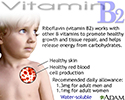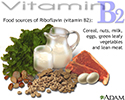Riboflavin
Vitamin B2
Riboflavin is a type of B vitamin. It is water soluble, which means it is not stored in the body. You must replenish the vitamin in your body every day.
Function
Riboflavin (vitamin B2) works with the other B vitamins. It is important for body growth and red blood cell production. It also aids in the release of energy from proteins.
Food Sources
The following foods provide riboflavin in the diet:
- Dairy products
- Eggs
- Green leafy vegetables
- Lean meats
- Organ meats, such as liver and kidneys
- Legumes
- Milk
- Nuts
Breads and cereals are often fortified with riboflavin. Fortified means the vitamin has been added to the food.
Riboflavin is destroyed by exposure to light. Foods with riboflavin should not be stored in clear containers that are exposed to light.
Side Effects
Deficiency of riboflavin is not common in the United States because this vitamin is plentiful in the food supply. Symptoms of a severe deficiency include:
-
Anemia
Anemia
Anemia is a condition in which the body does not have enough healthy red blood cells. Red blood cells provide oxygen to body tissues. Different type...
 ImageRead Article Now Book Mark Article
ImageRead Article Now Book Mark Article - Mouth or lip sores
- Skin disorders
- Sore throat
- Swelling of mucus membranes
- Growth failure
Because riboflavin is a water-soluble vitamin, leftover amounts leave the body through the urine. There is no known poisoning from riboflavin.
Recommendations
Recommendations for riboflavin, as well as other nutrients, are provided in the Dietary Reference Intakes (DRIs) developed by the Food and Nutrition Board at the Institute of Medicine. DRI is a term for a set of reference intakes that are used to plan and assess the nutrient intakes of healthy people. These values, which vary by age and gender, include:
Recommended Dietary Allowance (RDA): The average daily level of intake that is enough to meet the nutrient needs of nearly all (97 to 98%) healthy people. An RDA is an intake level based on scientific research evidence.
Adequate Intake (AI): This level is established when there is not enough scientific research evidence to develop an RDA. It is set at a level that is thought to ensure enough nutrition.
Because there is not enough evidence to determine an exact RDA for how much riboflavin you need, the amount of riboflavin needed in your diet is described in terms of Adequate Intake.
The Adequate Intakes (AI) for riboflavin (vitamin B2) are:
Infants
- 0 to 6 months: 0.3 milligrams per day (mg/day)
- 7 to 12 months: 0.4 mg/day
Children
- 1 to 3 years: 0.5 mg/day
- 4 to 8 years: 0.6 mg/day
- 9 to 13 years: 0.9 mg/day
Adolescents and adults
- Males age 14 and older: 1.3 mg/day
- Females age 14 to 18 years: 1.0 mg/day
- Females age 19 and older: 1.1 mg/day
- Pregnancy: 1.4 mg/day
- Lactation: 1.6 mg/day
The best way to get the daily requirement of essential vitamins is to eat a balanced diet that contains a variety of foods.
References
Institute of Medicine, Food and Nutrition Board. Dietary Reference Intakes: Thiamin, Riboflavin, Niacin, Vitamin B6, Folate, Vitamin B12, Pantothenic Acid, Biotin, and Choline. National Academy Press, Washington, DC, 1998. PMID: 23193625 www.ncbi.nlm.nih.gov/pubmed/23193625 .
Mason JB. Vitamins, trace minerals, and other micronutrients. In: Goldman L, Schafer AI, eds. Goldman's Cecil Medicine . 24th ed. Philadelphia, PA: Elsevier Saunders; 2011:chap 225.
Salwen MJ. Vitamins and trace elements. In: McPherson RA, Pincus MR, eds. Henry's Clinical Diagnosis and Management by Laboratory Methods . 22nd ed. Philadelphia, PA: Elsevier Saunders; 2011:chap 26.
-
Vitamin B2 benefit - illustration
Riboflavin, also called vitamin B2, releases energy from carbohydrates. B2 is destroyed by exposure to light, therefore foods with riboflavin should be keep in dark or opaque containers.
Vitamin B2 benefit
illustration
-
Vitamin B2 source - illustration
Like most vitamins, vitamin B2 (riboflavin) may be obtained in the recommended amount with a well-balanced diet, including some enriched or fortified foods.
Vitamin B2 source
illustration
-
Vitamin B2 benefit - illustration
Riboflavin, also called vitamin B2, releases energy from carbohydrates. B2 is destroyed by exposure to light, therefore foods with riboflavin should be keep in dark or opaque containers.
Vitamin B2 benefit
illustration
-
Vitamin B2 source - illustration
Like most vitamins, vitamin B2 (riboflavin) may be obtained in the recommended amount with a well-balanced diet, including some enriched or fortified foods.
Vitamin B2 source
illustration
Review Date: 2/2/2015
Reviewed By: Emily Wax, RD, The Brooklyn Hospital Center, Brooklyn, NY. Also reviewed by David Zieve, MD, MHA, Isla Ogilvie, PhD, and the A.D.A.M. Editorial team.


